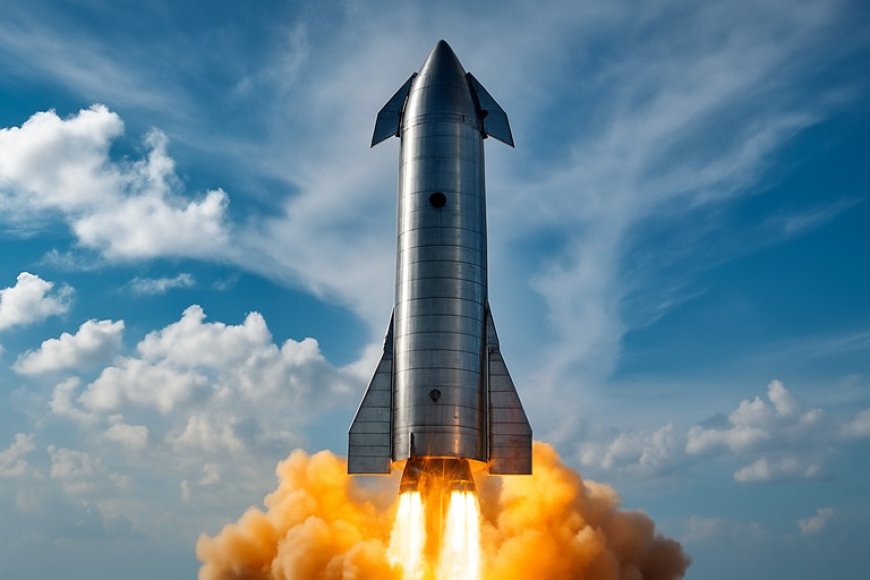SpaceX’s Upgraded Starship Explodes During Testing, Raising Safety Questions Ahead of 2025 Flights
SpaceX’s newly upgraded Starship prototype suffered a major explosion during a cryogenic structural test in South Texas. Here’s how the failure impacts the company’s 2025 mission timelines, Starship development, and upcoming orbital flights.

SpaceX’s Upgraded Starship Explodes During Testing — A Major Setback for the 2025 Flight Program
SpaceX has suffered another significant setback as its newly upgraded Starship prototype experienced a catastrophic explosion during a high-pressure test at its Boca Chica facility in South Texas. The incident has raised new questions about the company’s aggressive development timeline and its goal of conducting more frequent orbital launches in 2025. The spacex upgraded starship suffers explosion during testing 2025 update has already drawn global attention as the aerospace industry evaluates how this will impact SpaceX’s long-term Mars and deep-space ambitions.
The explosion reportedly occurred during a structural stress test involving updated components intended for the company’s next-generation Starship architecture. While no injuries were reported, the test stand and surrounding infrastructure sustained noticeable damage, and footage quickly went viral across aerospace communities and social media platforms.
🚀 What Happened During the Test?
According to early reports, SpaceX was conducting a cryogenic pressure test — a standard procedure to validate tank durability when filled with super-cooled liquid methane and liquid oxygen. The test involved an upgraded stainless-steel hull structure and reinforced weld lines designed to withstand higher loads for future heavy-payload missions.
However, sensors reportedly detected unexpected pressure fluctuations moments before the blast. Within seconds, the vehicle suffered a rapid structural failure, leading to a powerful explosion that sent debris across the test pad. Witnesses described a loud shockwave, followed by a fireball visible from miles away.
This type of testing is not new for SpaceX. The company has previously lost multiple prototypes during similar validation procedures, viewing failures as a natural part of rapid hardware iteration. But this particular incident stands out because it involved an upgraded Starship variant intended to support SpaceX’s more ambitious missions in the coming year.
🛠️ What Was New in the Upgraded Starship?
The prototype that exploded was part of the next evolution of the Starship system, developed after several successful high-altitude flights in 2024 and two partial orbital tests earlier in 2025. SpaceX is continuously refining Starship’s design, making updates every few months.
Key upgrades included:
- Reinforced 38-series stainless steel for higher thermal resistance
- Improved methane header tank for safer landing operations
- Updated Raptor 4 engine mounts compatible with the next engine revision
- New avionics wiring optimized for long-duration flights
- High-pressure cryogenic plumbing for heavier payload targeting Mars cargo flights
The explosion occurred before any engines were installed, meaning the vehicle was still in its early integration stage. This suggests the issue was most likely structural rather than propulsion-related.
🌎 Why Starship Development Matters for 2025 and Beyond
Starship is the world’s most powerful launch system under development, intended to support missions ranging from Starlink satellite deployment to lunar landings under NASA’s Artemis program. SpaceX has also marketed Starship as the spacecraft that will eventually carry humans to Mars.
For 2025, SpaceX has three major objectives:
- Conduct multiple orbital Starship flights with full reusability tests
- Deliver hardware for Artemis III, including the lunar lander variant
- Expand Starlink V3 satellite launches using the heavy-lift capacity of Starship
This explosion may not derail operations significantly, but it underscores the challenges SpaceX faces while attempting to iterate at unprecedented speeds.
📡 What This Means for the Artemis Moon Program
SpaceX is NASA’s chosen contractor to deliver astronauts onto the Moon through the Human Landing System (HLS), a modified Starship designed for lunar descent and ascent. The project already carries a tight timeline, with NASA expecting major hardware milestones in late 2025.
While the exploded prototype was not an HLS-specific model, any testing delays could ripple across SpaceX’s overall roadmap, impacting engine development, safety validation, and manufacturing capacity.
NASA has not yet released an official statement, but internal sources say NASA is closely monitoring the situation. SpaceX must still complete several key milestones, including:
- Successful orbital refueling demonstration
- Multiple safe reentries of Starship
- Full environmental compliance at the Boca Chica site
A setback in testing could make meeting all of these milestones more challenging.
🔥 SpaceX’s History of Explosive Testing
This isn’t the first time SpaceX has lost a vehicle on the test stand. Over the last five years, the company has encountered multiple rapid unplanned disassemblies (RUDs) during fueling, engine testing, and cryogenic pressure evaluations.
Previous incidents include:
- Starship SN1 pressure test failure in 2020
- SN3 cryogenic test collapse
- SN4 explosion following a ground support equipment leak
- SN10 hard landing explosion
- Booster engine bay explosion in 2023
Elon Musk has famously stated that rapid iteration, including destructive testing, is essential to accelerating development. However, some analysts argue that this approach comes with predictable risks and occasional schedule disruption.
🛰️ Will This Delay Starship’s Next Test Flight?
SpaceX has not officially announced delays yet, but internal timelines suggest that the next orbital test vehicle may require additional review. The company usually builds several prototypes in parallel, making it possible to shift testing to another nearly completed vehicle.
The main question is whether the root cause is limited to one prototype or affects the upgraded design as a whole. If it is systemic, SpaceX may need to revise weld procedures, tank wall thicknesses, or cryogenic plumbing layouts — all of which could slow things down.
If contained to a single unit, SpaceX may proceed with minimal schedule impact.
🌐 Public and Industry Reaction
Aerospace experts have expressed mixed reactions. Some view this as a normal—and even expected—part of SpaceX’s aggressive testing philosophy. Others see it as a reminder that developing a fully reusable spacecraft is extraordinarily complex.
Online communities also responded quickly. Starbase watchers, engineers, and space enthusiasts shared footage and analysis across X, Reddit, and YouTube, generating millions of views within hours. Many praised SpaceX’s transparency in allowing livestreams and public visibility of testing activity.
⚖️ Regulatory Oversight and Environmental Considerations
The explosion may prompt increased review from regulatory authorities, including the FAA, which already monitors Starship development under strict environmental and safety guidelines.
Potential regulatory impacts include:
- Additional safety audits at the Starbase site
- Updated risk assessments for nearby communities
- Temporary limits on test operations
- Environmental reviews due to debris footprint
The FAA previously grounded Starship after orbital test anomalies in 2023 and 2024 — so another detailed review is likely.
🔮 What Comes Next for SpaceX?
Despite the setback, SpaceX is known for rapidly diagnosing hardware failures and pushing forward. Engineers will now analyze the debris, examine sensor logs, and reconstruct the timeline using high-speed camera footage.
Expected next steps include:
- Root-cause analysis of the tank failure
- Material and weld inspection
- Revised structural simulations for cryogenic loading
- Accelerated production of the next prototype
Given the number of Starship prototypes under construction, SpaceX could potentially resume major testing within weeks — assuming the issue is not systemic.
📚 Sources & Further Reading
Sneak peek: Despite the unexpected explosion, SpaceX continues its rapid push toward reusable rockets, lunar missions, and eventually human flights to Mars — proving once again that innovation often comes with calculated risk.
What's Your Reaction?
 Like
0
Like
0
 Dislike
0
Dislike
0
 Love
0
Love
0
 Funny
0
Funny
0
 Angry
0
Angry
0
 Sad
0
Sad
0
 Wow
0
Wow
0



















































